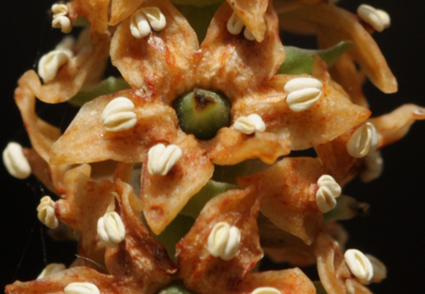Abstract
Rohdea longianthera is described and illustrated as a new species, which is endemic to Chuxiong, western Yunnan, Southwest China. The new species is closely related to R. longipedunculata, but it is actually distinguishable from the latter by the anthers inserted near apex of tube, 2.5–3 mm long and sharply inflexed incrassate deltoid perianth lobes of which the margins are entire, thick and scarcely imbricate. The phenology, distribution and provisional assessment of conservation status of the new taxon are provided. An identification key to all Rohdea species that occur in Yunnan, China is provided for easy identification.
References
- APG IV (2016) An update of the Angiosperm Phylogeny Group classification for the orders and families of flowering plants: APG IV. Botanical Journal of the Linnean Society 181: 1–20. https://doi.org/10.1111/boj.12385
- Baker, J.G. (1875) Revision of the genera and species of Asparagaceae. Journal of the Linnean Society 14: 508–632. https://doi.org/10.1111/j.1095-8339.1875.tb00349.x
- Chen, Q.H. (1987) A new species of Tupistra (Liliaceae) from Guizhou. Acta Phytataxonomica Sinica 25 (1): 69–70.
- Franchet, A. (1896) Note Sur Quelques Liliacées De La Chine Occidentale. Bulletin de la Société botanique de France 43: 37–48. https://doi.org/10.1080/00378941.1896.10828845
- Huang, J.L. & Li, H. (1990) Study on the taxonomic system of the genus Tupistra. Acta Botanica Yunnanica Supple 3: 49–61.
- IUCN Standards and Petitions Subcommittee (2022) Guidelines for using IUCN Red List Categories and Criteria. Version 15. Prepared by the Standards and Petitions Subcommittee. Available from: https://www.iucnredlist.org/documents/RedListGuidelines.pdf (accessed 16 April 2022)
- Li, H. (1997) Tupistra. In: Wu, Z.Y. (Eds.) Flora of Yunnanica. Science Press, Beijing, pp. 705–716.
- Liang, S.Y. & Tanama, M.N. (2000) Tupistra, Rohdea. In: Wu, Z.Y. & Raven, P.H. (Eds.) Flora of China 24. Missouri Botanical Garden, St. Louis & Sciences Press, Beijing, pp. 235–239.
- Roth, A.W. (1821) Novae plantarum species praesertim Indiae orientalis: Ex collectione doct. Benj. Heynii: cum descriptionibus et observationibus. Sumptibus H. Vogler, Halberstadii, 412 pp. https://doi.org/10.5962/bhl.title.10723
- POWO (2024) Plants of the World Online. Facilitated by the Royal Botanic Gardens, Kew. Available from: http://www.plantsoftheworldonline.org/ (accessed 27 June 2024)
- Tanaka, N. (2003) New combinations in Rohdea (Convallariaceae). Novon 13: 329–333. https://doi.org/10.2307/3393269
- Tanaka, N. (2010) A taxonomic revision of the genus Rohdea (Asparagaceae) Makinoa New Series 9: 1–54.
- Tamura, M.N., Liang, S.Y. & Turland, N.J. (2000) New combinations in Campylandra (Convallariaceae, Convallarieae). Novon 10: 158–160. https://doi.org/10.2307/3393019
- Wang, F.T. & Tang, T. (1978) Flora Reipublicae Popularis Sinicae 15. Science Press, Beijing, 280 pp.
- Yamashita, J. & Tamura, M.N. (2004) Phylogenetic analyses and chromosome evolution in Convallarieae (Ruscaceae sensu lato), with some taxonomic treatments. Journal of Plant Research 117: 363–370. https://doi.org/10.1007/s10265-004-0169-z


